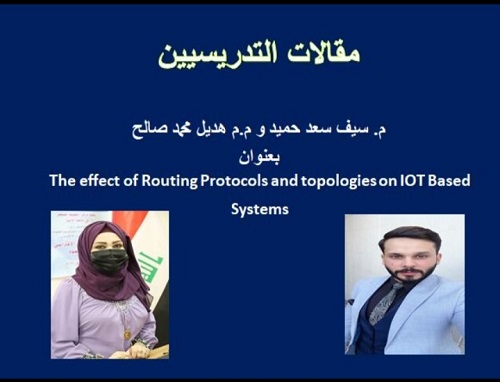
مقال اكاديمي بعنوان تأثير بروتوكولات التوجيه والطبولوجيا على الأنظمة القائمة على إنترنت الأشياء
The effect of Routing Protocols and topologies on IOT Based Systems
م. سيف سعد حميد
(للاطلاع على الصفحة الرسمية للتدريسي اضغط هنا)
(للاطلاع على الصفحة الرسمية للتدريسي اضغط هنا)
Internet of Things has appeared as a Possible Future Scenario of the applicability and effect of technology in human life. Internet of Things spreads the understandable of Internet from a network of rather similar devices such as computers to network of dissimilar devices such as home applications, consumer electronics or wireless sensor networks. As developed from traditional network such as Internet, Internet of Things networks head for to re-use techniques which are advanced for Internet such as routing protocols ,,,THE Internet of Things (IoT) is a recent communication model that imagines a near future, in which the objects of everyday life will be equipped with microcontrollers, transceivers for digital communication, and suitable protocol stacks that will make them able to communicate with one another and with the users, becoming an integral part of the Internet.[1]
Routing protocols are arranged on routers with the objective of replacing routing information there are two types of routing protocols are distance vector include RIP(routing information protocols) and IGRP(Internet Gateway routing protocol ) and link state such as OSPF(Open Shortest Path First) and another protocols [2] Cisco advanced Internet Gateway Routing Protocol as another alternative to RIP. The most recent Enhanced IGRP (EIGRP) made IGRP ancient beginning in the 1990s.[3]
Network Scenarios
Altered scenarios executed using “Opnet-Modular-14.5”, the scenarios cover small, medium and large networks with altered topologies including SRT, SMT, LMT, and LTT. The simulation of network covers an evaluation of performance on network routing in term of traffic sent capability and the Link time of the router.
The Network Scenario are :
1-3rd Network Scenario.
2- SRT Scenario.
3- SMT Scenario.
4- LMT Scenario.
5- LTT Scenario.




